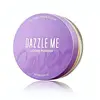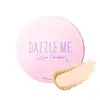What's inside
What's inside
 Key Ingredients
Key Ingredients

 Benefits
Benefits

 Concerns
Concerns

 Ingredients Side-by-side
Ingredients Side-by-side

Mica
Cosmetic ColorantNylon-12
Tridecyl Trimellitate
EmollientDimethicone
EmollientPhenoxyethanol
PreservativeTocopherol
AntioxidantParfum
MaskingNiacinamide
SmoothingOenothera Biennis Flower/Leaf/Stem Extract
Skin ConditioningCamellia Japonica Flower Extract
EmollientHamamelis Virginiana Extract
AntiseborrhoeicResveratrol
AntioxidantCI 77492
Cosmetic ColorantCI 77491
Cosmetic ColorantCI 77499
Cosmetic ColorantCorn Starch Modified
AbsorbentSilica
AbrasiveSynthetic Fluorphlogopite
Mica
Cosmetic ColorantPhenoxyethanol
PreservativeMagnesium Myristate
Dimethicone
EmollientTocopheryl Acetate
AntioxidantTriethoxycaprylylsilane
Titanium Dioxide
Cosmetic ColorantPhenyl Trimethicone
Skin ConditioningParfum
MaskingAluminum Hydroxide
EmollientEthylhexylglycerin
Skin ConditioningCyclopentasiloxane
EmollientPolymethylsilsesquioxane
Hydrated Silica
AbrasiveHydrogen Dimethicone
Ascorbic Acid
AntioxidantArbutin
AntioxidantEthylhexyl Palmitate
EmollientSaccharomyces/Rice Ferment Filtrate
Skin ConditioningWater
Skin ConditioningHydrogenated Polyisobutene
EmollientGlycerin
HumectantHydrogenated Lecithin
EmulsifyingCalendula Officinalis Flower Extract
MaskingCeramide NP
Skin ConditioningCaprylyl Glycol
EmollientPropylene Glycol
HumectantChrysanthellum Indicum Extract
Skin ConditioningButylene Glycol
HumectantTrihydroxystearin
Skin Conditioning1,2-Hexanediol
Skin ConditioningSodium Hyaluronate
HumectantGlucomannan
Skin ConditioningCI 77891
Cosmetic ColorantCI 77492
Cosmetic ColorantCI 77491
Cosmetic ColorantCorn Starch Modified, Silica, Synthetic Fluorphlogopite, Mica, Phenoxyethanol, Magnesium Myristate, Dimethicone, Tocopheryl Acetate, Triethoxycaprylylsilane, Titanium Dioxide, Phenyl Trimethicone, Parfum, Aluminum Hydroxide, Ethylhexylglycerin, Cyclopentasiloxane, Polymethylsilsesquioxane, Hydrated Silica, Hydrogen Dimethicone, Ascorbic Acid, Arbutin, Ethylhexyl Palmitate, Saccharomyces/Rice Ferment Filtrate, Water, Hydrogenated Polyisobutene, Glycerin, Hydrogenated Lecithin, Calendula Officinalis Flower Extract, Ceramide NP, Caprylyl Glycol, Propylene Glycol, Chrysanthellum Indicum Extract, Butylene Glycol, Trihydroxystearin, 1,2-Hexanediol, Sodium Hyaluronate, Glucomannan, CI 77891, CI 77492, CI 77491
Ingredients Explained
These ingredients are found in both products.
Ingredients higher up in an ingredient list are typically present in a larger amount.
Ci 77491 is also hydrated iron III oxide. It's sole purpose is to give a red/pink hue to products.
Iron III oxides are classified as inorganic chemicals for coloring.
Synthetically created Ci 77491 is considered safer than those naturally found. This is because the synthetically created version may contain less impurities. Iron oxides are generally non-toxic and non-allergenic.
Learn more about CI 77491Ci 77492 is also hydrated iron III oxide. It's sole purpose is to give a yellow hue to products.
Iron III oxides are classified as inorganic chemicals for coloring.
Synthetically created Ci 77492 is considered safer than those naturally found. This is because the synthetically created version may contain less impurities. Iron oxides are generally non-toxic and non-allergenic.
Learn more about CI 77492Dimethicone is a type of synthetic silicone created from natural materials such as quartz.
What it does:
Dimethicone comes in different viscosities:
Depending on the viscosity, dimethicone has different properties.
Ingredients lists don't always show which type is used, so we recommend reaching out to the brand if you have questions about the viscosity.
This ingredient is unlikely to cause irritation because it does not get absorbed into skin. However, people with silicone allergies should be careful about using this ingredient.
Note: Dimethicone may contribute to pilling. This is because it is not oil or water soluble, so pilling may occur when layered with products. When mixed with heavy oils in a formula, the outcome is also quite greasy.
Learn more about DimethiconeMica is a naturally occurring mineral used to add shimmer and color in cosmetics. It can also help improve the texture of a product or give it an opaque, white/silver color.
Serecite is the name for very fine but ragged grains of mica.
This ingredient is often coated with metal oxides like titanium dioxide. Trace amounts of heavy metals may be found in mica, but these metals are not harmful in our personal products.
Mica has been used since prehistoric times throughout the world. Ancient Egyptian, Indian, Greek, Roman, Aztec, and Chinese civilizations have used mica.
Learn more about MicaParfum is a catch-all term for an ingredient or more that is used to give a scent to products.
Also called "fragrance", this ingredient can be a blend of hundreds of chemicals or plant oils. This means every product with "fragrance" or "parfum" in the ingredients list is a different mixture.
For instance, Habanolide is a proprietary trade name for a specific aroma chemical. When used as a fragrance ingredient in cosmetics, most aroma chemicals fall under the broad labeling category of “FRAGRANCE” or “PARFUM” according to EU and US regulations.
The term 'parfum' or 'fragrance' is not regulated in many countries. In many cases, it is up to the brand to define this term.
For instance, many brands choose to label themselves as "fragrance-free" because they are not using synthetic fragrances. However, their products may still contain ingredients such as essential oils that are considered a fragrance by INCI standards.
One example is Calendula flower extract. Calendula is an essential oil that still imparts a scent or 'fragrance'.
Depending on the blend, the ingredients in the mixture can cause allergies and sensitivities on the skin. Some ingredients that are known EU allergens include linalool and citronellol.
Parfum can also be used to mask or cover an unpleasant scent.
The bottom line is: not all fragrances/parfum/ingredients are created equally. If you are worried about fragrances, we recommend taking a closer look at an ingredient. And of course, we always recommend speaking with a professional.
Learn more about ParfumPhenoxyethanol is a preservative that has germicide, antimicrobial, and aromatic properties. Studies show that phenoxyethanol can prevent microbial growth. By itself, it has a scent that is similar to that of a rose.
It's often used in formulations along with Caprylyl Glycol to preserve the shelf life of products.